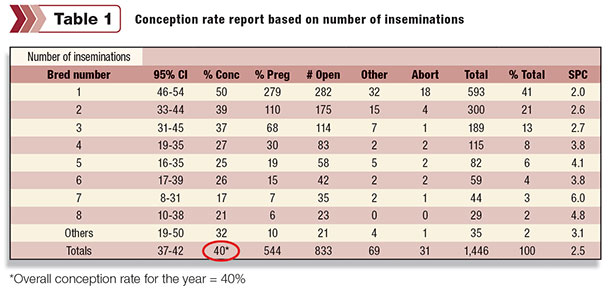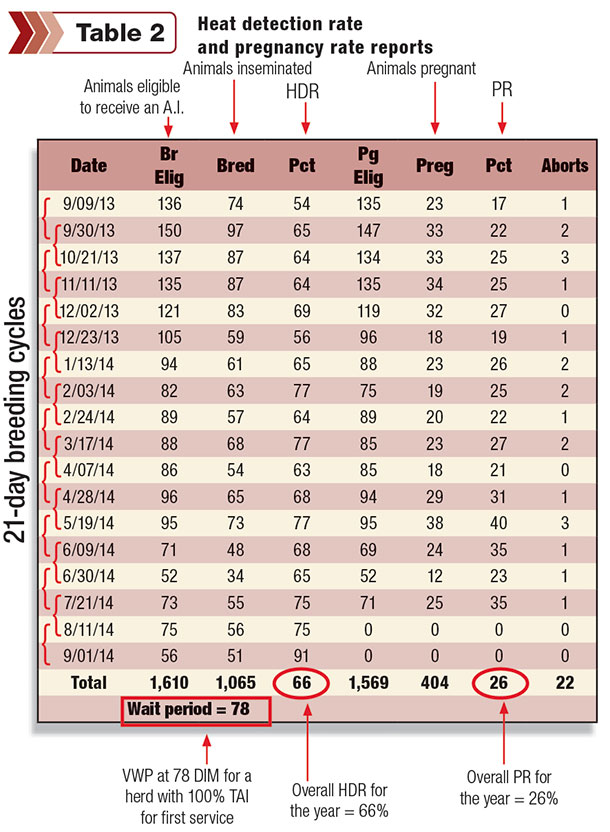When we talk about how to evaluate reproductive performance in a dairy herd, numerous terms come up in the discussion. Some of these terms are related to averages, and others are related to rates (or risks).
Average days open, average days in milk at first breeding, average interbreeding interval, percentage of the herd pregnant, average calving interval and conception rate (or pregnancies per A.I.) are some examples of the first category, while heat detection rate (or insemination risk or service rate) and pregnancy rate (or pregnancy risk) are examples of the second category.
But what do they really mean? Why are averages not the best way to determine reproductive performance rates? How are they calculated? Let’s see some examples and understand what is really happening with a dairy’s reproductive program.
Average, by definition, represents a value that is an approximation of the arithmetic mean. Averages are good to evaluate overall execution, but they are not the best way to fully evaluate performance. By way of example, let’s say we will compare two dairies with replacement heifers delivering their first calf every year, with an average age at first calving of 23 months.
Dairy A has a range of heifers calving from 20 to 30 months old, while Dairy B ranges from 22 to 26 months. Even though they have the same average, we can say that Dairy B is more competent at getting heifers bred and pregnant in a timely manner compared to Dairy A. This definition is true for all averages that are calculated on a herd, listed above.

-
Conception rate: With the same idea, we can include the conception rate, or pregnancies per A.I. (P per A.I.). Conception rate (CR) is calculated based on the number of cows that become pregnant divided by the number of cows that were inseminated.
In other words, we evaluate the ability of cows to get pregnant with no “time component” into the calculation. Let’s say that last year, one herd had 40 percent overall CR. We do not know when eligible cows became pregnant; we only know that out of 100 inseminations, 40 were successful.
However, to evaluate effectiveness of a reproductive program, it is really important to combine how efficiently cows are getting pregnant with how fast animals are being submitted to an A.I., giving them a chance to become pregnant in a herd. For this, we have to understand some terms and how the calculation is done.
-
Voluntary waiting period: The first and the most important term is the voluntary waiting period (VWP). The VWP is not a calculation per se. It is a term that describes a management decision based on when (days in milk) cows will receive their first insemination after calving. This term is important because it is the starting point for the calculation of rates that are “timing-sensitive.”
Heat detection rate and pregnancy rate are calculated on a 21-day period, based on cows that are eligible to receive an insemination and become pregnant during this time frame. It is a 21-day piece of information that is calculated one after another in breeding cycles. Cows eligible for more cycles without receiving insemination or becoming pregnant will have a negative impact on these calculations.
-
Heat detection rate: Heat detection rate (also referred to as insemination risk or service rate) is a number that is calculated based on the number of inseminations performed in a 21-day period divided by the number of possible (or eligible) inseminations.
Animals that are eligible to be inseminated fit into the following categories: animals that passed the herd’s VWP, animals that are not pregnant and animals that are not included on the culling decision list, normally coded as do not breed (DNB).
For example, in a time frame from Jan. 13 to Feb. 3, a herd had 94 cows eligible to receive A.I., and 61 cows were actually inseminated. The heat detection rate (HDR) for this cycle was 65 percent, and the average HDR for all the 17 cycles we have in one year will determine the average HDR for this herd.
That is why the delimitation of the VWP on a dairy is so important. Let’s evaluate how insemination rhythm can influence calculations of HDR on a dairy with its VWP stipulated at 50 days in milk (DIM).
Cows that are inseminated before the VWP are not included on the calculation, and cows that receive their first A.I. with 100 DIM have been eligible for almost two-and-a-half cycles (first cycle: 50 + 21 = 71; second cycle: 71 + 21 = 92) after the end of the VWP and were waiting that long to get a chance to become pregnant for the first time. These strategies will negatively affect the calculation.
Added to this, the moment for the pregnancy diagnosis and the management decision of what to do with cows presented as not pregnant by the veterinarian is also important and has an impact on the calculation. Inseminated cows will normally display estrous behavior 17 to 23 days after a previous A.I., and in herds that are performing estrous detection, these cows will be re-inseminated.

Cows not seen in estrus are presented to the veterinarian or have their blood or milk collected for a pregnancy diagnosis. Early diagnosis can be performed between 28 and 34 days since last A.I., usually with ultrasound equipment or a biochemical test, and late diagnoses are performed between 35 and 42 days since last A.I. with manual palpation per rectum of the uterine contents.
After a negative pregnancy diagnosis, cows need to be re-inseminated, either by a stimulation of estrous behavior with a prostaglandin injection or after a completion of a timed-A.I. protocol, known as a Resynch.
In this scenario, cows will be 30 to 50 days since last A.I. to receive another chance to become pregnant, and with the longer interval, cows pass through more cycles without being re-inseminated. This can also have a negative effect on the calculation.
-
Pregnancy rate: Following the same idea, the calculation for the pregnancy rate (or pregnancy risk) takes into consideration the same concept. The calculation is also performed on a 21-day time period, where the number of cows that become pregnant is divided by the number of cows that are eligible to become pregnant (past the VWP, not pregnant and not DNB).
This number shows how fast eligible cows are becoming pregnant in a herd. And aligned with the same concepts, everything that affects how fast cows are receiving A.I. and affects the ability of cows to become pregnant will also affect the herd’s pregnancy rate, for the better or for the worse.
That’s why, when we are evaluating reproductive performance, we cannot take only one number or average into consideration. It’s a combination of management decisions, aggressiveness in finding eligible cows to receive A.I. and consistency of the breeding program and A.I. technique that will determine the effectiveness and adequacy of your reproductive performance. PD
Glaucio Lopes is a veterinarian. He graduated from Brazil and received his master’s degree in reproduction of dairy cows at the Department of Dairy Science at the University of Wisconsin – Madison. He is employed by Accelerated Genetics as a reproduction specialist.

-
Glaucio Lopes
- Reproduction Specialist
- Accelerated Genetics






